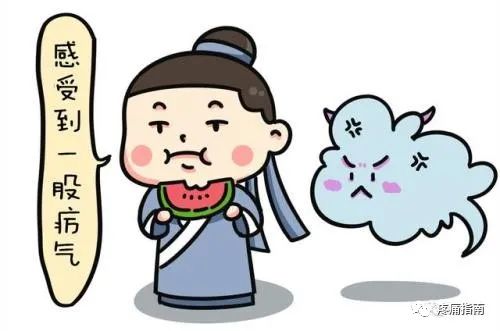
Click↑ Follow us in blue!
(1) Basic Concept of Epidemic Qi

Epidemic Qi (lè qì) is a type of highly infectious pathogenic factor, also known as malevolent Qi, epidemic Qi, toxic Qi, foreign Qi, mixed Qi, and perverse Qi. Epidemic Qi is transmitted through the air and contact. Unlike the Six Excesses (liù yín), it is not caused by climatic changes but is a minuscule substance (pathogenic microorganisms) that cannot be directly observed by human senses, referred to as a “toxic” pathogen. Epidemic Qi enters the body through the mouth and nose, thus it is classified as an external pathogenic factor. Diseases caused by Epidemic Qi, which are characterized by severe infectious outbreaks, are referred to as epidemics, pestilences, or plagues. Warm diseases differ from pestilences; warm diseases are a general term for various acute febrile diseases caused by external factors, which are non-infectious and non-epidemic.

(2) Nature and Pathogenic Characteristics of Epidemic Qi

1. Sudden onset and critical condition: Epidemic Qi is characterized by rapid onset, burning heat, and intense toxicity. Therefore, its pathogenicity is marked by sudden onset, fierce aggression, critical conditions, rapid changes, and quick transmission, easily harming body fluids, disturbing the spirit, causing blood movement, and generating wind. The harm caused by Epidemic Qi resembles that of fire heat, exhibiting a strong heat pattern; however, the toxic heat is more severe than fire heat, often accompanied by damp toxins, toxic mists, and miasmas, making its pathogenic effects more intense and dangerous, with a high mortality rate.
2. Strong infectivity and ease of spread: Epidemic Qi possesses strong infectivity and epidemic potential, capable of spreading through various routes such as the mouth and nose among populations. Epidemic Qi can occur sporadically or spread widely. Thus, it is characterized by strong infectivity, widespread epidemics, and high mortality rates. Examples include big head plague (characterized by redness and swelling of the head and face or sore throat due to epidemic toxins), toad plague (enlargement of the neck after exposure to epidemic toxins, resembling a toad), epidemic dysentery, diphtheria, rotten throat, smallpox, cholera, and plague, which encompass many infectious diseases and severe infectious diseases recognized by modern medicine.
3. Specificity and partial neutrality: Specificity refers to the specific locations and types of diseases caused by Epidemic Qi. The effects of Epidemic Qi on specific organs and the diseases it causes are characterized by specific localization. Epidemic Qi has a certain selectivity for the affected areas, resulting in corresponding clinical manifestations in different locations. Different types of Epidemic Qi lead to different diseases, each with its own clinical features and transmission patterns, known as “one Qi causes one disease.” Partial neutrality refers to the susceptibility of Epidemic Qi to different species. Epidemic Qi may affect humans or animals; if it affects humans, it does not transmit to animals, and vice versa. Even if it affects animals, due to species differences, it does not transmit among them.
In summary, both the Six Excesses and Epidemic Qi are classified as external pathogenic factors, differing in nature and pathogenic characteristics, but the diseases they cause are often characterized by heat patterns, thus commonly referred to as external heat diseases.
 Next Issue Preview
Next Issue Preview Internal Injury Pathogens, also known as internal injuries, refer to pathogenic factors arising from emotional or behavioral deviations that exceed the body’s self-regulatory capacity, directly harming the organs and causing disease, such as emotional injuries, improper diet, and imbalanced work and rest. Internal injury pathogens lead to imbalances in Qi, blood, Yin, and Yang in the organs. Diseases caused by internal injury pathogens are referred to as internal injury diseases. Internal injury pathogens are contrasted with external pathogenic factors, as they arise from within rather than from external invasion, hence termed internal injuries.
Internal Injury Pathogens, also known as internal injuries, refer to pathogenic factors arising from emotional or behavioral deviations that exceed the body’s self-regulatory capacity, directly harming the organs and causing disease, such as emotional injuries, improper diet, and imbalanced work and rest. Internal injury pathogens lead to imbalances in Qi, blood, Yin, and Yang in the organs. Diseases caused by internal injury pathogens are referred to as internal injury diseases. Internal injury pathogens are contrasted with external pathogenic factors, as they arise from within rather than from external invasion, hence termed internal injuries.
Diet is a fundamental condition for health. The essence derived from food and drink is essential for generating Qi and blood, maintaining growth and development, performing various physiological functions, and ensuring life and health.
Normal diet is one of the main sources for maintaining the balance of Qi, blood, Yin, and Yang in the body; however, improper diet is often a cause of many diseases. The digestive and absorptive functions primarily rely on the spleen and stomach; if the diet is improper, it can first damage the spleen and stomach, leading to dysfunction in their ability to transform and transport, causing digestive disorders. Additionally, it can generate heat, phlegm, and dampness, leading to various pathological changes, becoming a significant cause of disease. Improper diet includes excessive or insufficient eating, unclean food, and dietary preferences. Improper diet can lead to disease occurrence and is one of the main pathogenic factors of internal injury diseases.
Work and Rest, includes both excessive fatigue and excessive leisure. Normal labor and physical exercise help promote the circulation of Qi and blood, enhancing physical fitness. Necessary rest can eliminate fatigue and restore physical and mental strength without causing disease. Only prolonged excessive fatigue, whether from physical labor, mental work, or sexual activity, or complete inactivity, can become pathogenic factors leading to illness.
This article is sourced from the internet; if there is any infringement, please contact for removal!
Your likes are our motivation for progress!
↘↘↘

